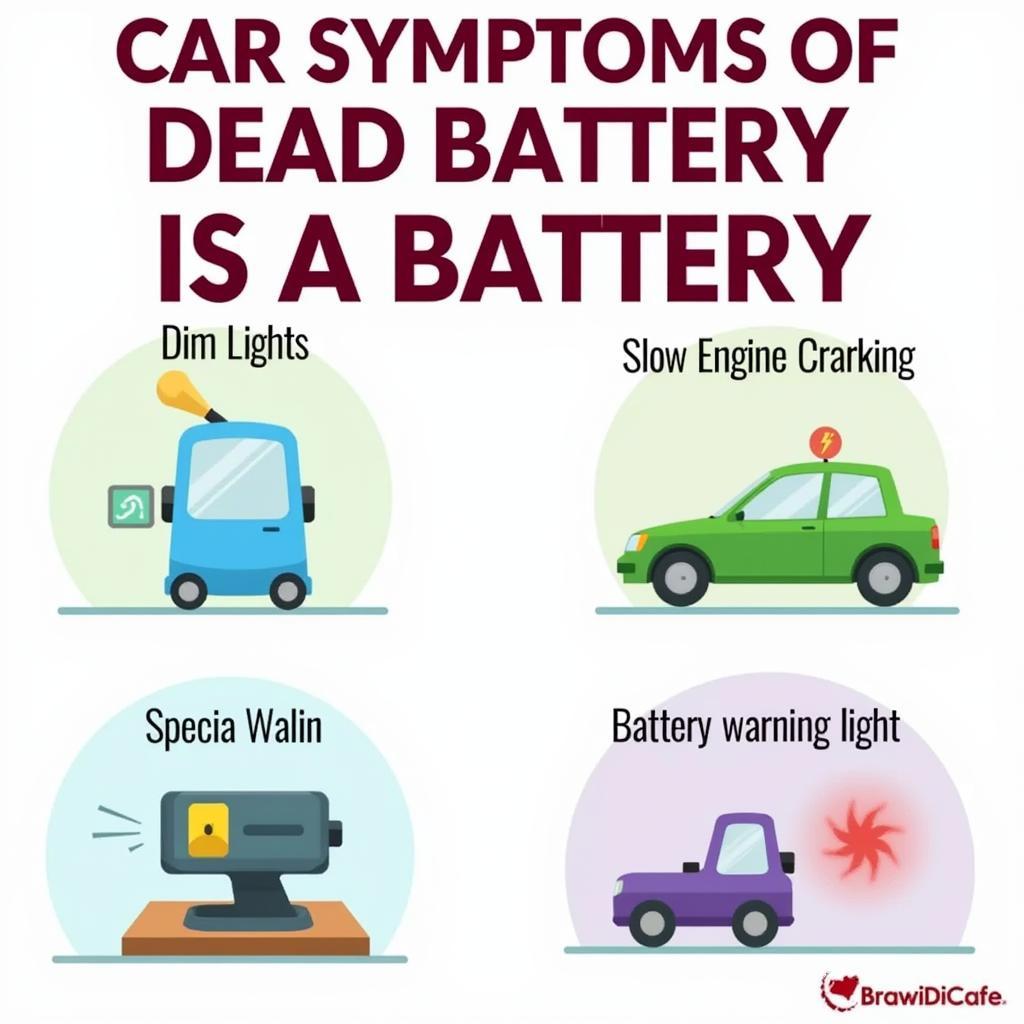A dead car battery is a frustrating experience, leaving you stranded and scrambling for solutions. This common issue can be caused by various factors, from age and wear to extreme temperatures and electrical drains. Understanding the reasons behind a dead battery and the steps to take when it happens is crucial for every car owner. This comprehensive guide will equip you with the knowledge and tools to address this problem effectively.
Why Did My Car Battery Die?
A car battery’s primary function is to provide power for the starter motor, enabling the engine to turn over and ignite. Over time, batteries lose their capacity to store and deliver energy, leading to a weakened or dead battery.
Here are some common culprits that can lead to a dead car battery:
- Old Age: Car batteries have a limited lifespan, typically lasting 3 to 5 years. As they age, their internal components deteriorate, reducing their ability to hold a charge.
- Extreme Temperatures: Both hot and cold temperatures can negatively impact battery performance. Heat accelerates chemical reactions within the battery, depleting its charge faster. Cold temperatures, on the other hand, slow down chemical reactions, making it difficult for the battery to produce sufficient power.
- Electrical Drains: Leaving lights or other accessories on, even for short periods, can drain the battery. Parasitic draws, caused by faulty electrical components, can silently drain the battery even when the car is off.
- Corrosion: Corrosion on battery terminals can restrict the flow of electricity, hindering charging and discharge processes.
- Undercharging: If the battery is not fully charged during normal driving, it can gradually lose capacity over time, eventually leading to a dead battery.
- Overcharging: While rare, overcharging can damage the battery’s internal components, leading to premature failure.
- Deep Discharges: Repeatedly draining the battery to a very low level can shorten its lifespan.
How to Jump Start Your Car with a Dead Battery
If your car battery is dead, a jump start is often the quickest and most effective solution. It involves using a good battery from another car to provide temporary power to your car’s battery, allowing you to start the engine and recharge the battery.
Here’s how to jump start your car:
- Gather your tools: You’ll need a set of jumper cables and another car with a working battery.
- Park the cars: Park the two cars close together, but ensure they are not touching.
- Connect the cables:
- Positive (red) cable: Connect one end to the positive (+) terminal of the good battery and the other end to the positive (+) terminal of the dead battery.
- Negative (black) cable: Connect one end to the negative (-) terminal of the good battery and the other end to a metal grounding point on the dead car’s frame (not the battery).
- Start the engine: Start the engine of the good car and let it run for a few minutes.
- Start the dead car: Attempt to start the engine of the dead car. It may take a few tries.
- Disconnect the cables: Once the dead car is started, let it run for at least 15 minutes to allow the battery to recharge. Then, disconnect the jumper cables in reverse order, starting with the negative (black) cable.
Important Note: Always be cautious while working with batteries and jumper cables. Avoid touching the battery terminals or the metal cable ends, as this can cause a painful shock.
Signs of a Failing Battery
If you notice any of the following symptoms, your car battery may be failing and should be inspected or replaced soon:
- Slow engine cranking: The engine struggles to turn over, especially in cold weather.
- Dim headlights: The headlights appear noticeably dim, especially when the engine is running.
- Electrical problems: Other electrical components, such as the radio or power windows, may malfunction.
- Battery light: The battery warning light on the dashboard may illuminate.
- Battery corrosion: White, green, or blue corrosion on the battery terminals is a sign of battery deterioration.
How to Prevent a Dead Battery
Taking preventative measures can significantly reduce the risk of a dead car battery. Here are some practical tips:
- Regular maintenance: Have your battery tested regularly by a mechanic, especially if it’s nearing the end of its expected lifespan.
- Keep terminals clean: Clean battery terminals periodically with a wire brush and baking soda solution to remove corrosion.
- Minimize electrical drains: Avoid leaving headlights, interior lights, or other accessories on when the engine is off.
- Drive frequently: Regular driving helps keep the battery charged. If you drive infrequently, consider starting your car and letting it run for 15-20 minutes once a week.
- Consider a battery tender: A battery tender is a device that maintains a battery’s charge even when the car is not in use.
- Install an alarm system: Many modern alarm systems have a battery backup feature that can drain the main battery if it is not functioning properly.
When to Replace Your Car Battery
If your car battery is showing signs of failing, it’s time to consider replacement. A dead battery can leave you stranded, and replacing it early can prevent future problems.
Here are some indicators that it’s time to replace your car battery:
- Age: Most car batteries last 3 to 5 years. If your battery is nearing the end of its expected lifespan, it’s a good idea to have it inspected.
- Battery light: If the battery warning light on your dashboard is illuminated, it’s a clear indication that the battery needs attention.
- Performance issues: If you experience slow engine cranking, dim headlights, or other electrical problems, the battery may be failing.
- Corrosion: Excessive corrosion on the battery terminals is a sign of deterioration.
Expert Quote:
“A healthy car battery is essential for a reliable vehicle. Regular maintenance and attention to potential problems can help prevent costly repairs and ensure a smooth driving experience,” says John Smith, a certified automotive technician with over 20 years of experience.
Frequently Asked Questions (FAQs)
Q: How long does it take to charge a car battery?
A: Charging time varies depending on the battery type and charger used. A typical car battery takes 12-24 hours to fully charge using a standard trickle charger. Faster chargers can reduce the time, but it’s essential to follow the manufacturer’s instructions.
Q: Can I jump start my car with a different type of battery?
A: It’s generally safe to use a different type of battery for jump starting, but it’s best to use a battery with similar voltage and capacity.
Q: What happens if I leave my car battery charger connected for too long?
A: Leaving a battery charger connected for too long can lead to overcharging, which can damage the battery and shorten its lifespan. Always disconnect the charger once the battery is fully charged.
Q: Can I use a regular car battery charger to charge a motorcycle battery?
A: No, you should not use a regular car battery charger for a motorcycle battery. Motorcycle batteries have lower voltage and capacity requirements.
Q: How can I prevent parasitic battery drains?
A: You can have your car’s electrical system checked by a mechanic to identify and address any faulty components that may be causing a parasitic drain. You can also disconnect the battery terminals when your car is not in use for extended periods.
 Symptoms of a Dead Car Battery
Symptoms of a Dead Car Battery
Conclusion
A dead car battery can be an inconvenience, but it’s a problem that can be addressed with proper understanding and preventative measures. By following the tips and guidelines outlined in this guide, you can minimize the risk of a dead battery and ensure a reliable driving experience. If you’re facing a dead battery or have any concerns about your car battery’s health, consult with a qualified mechanic for professional advice and assistance.

